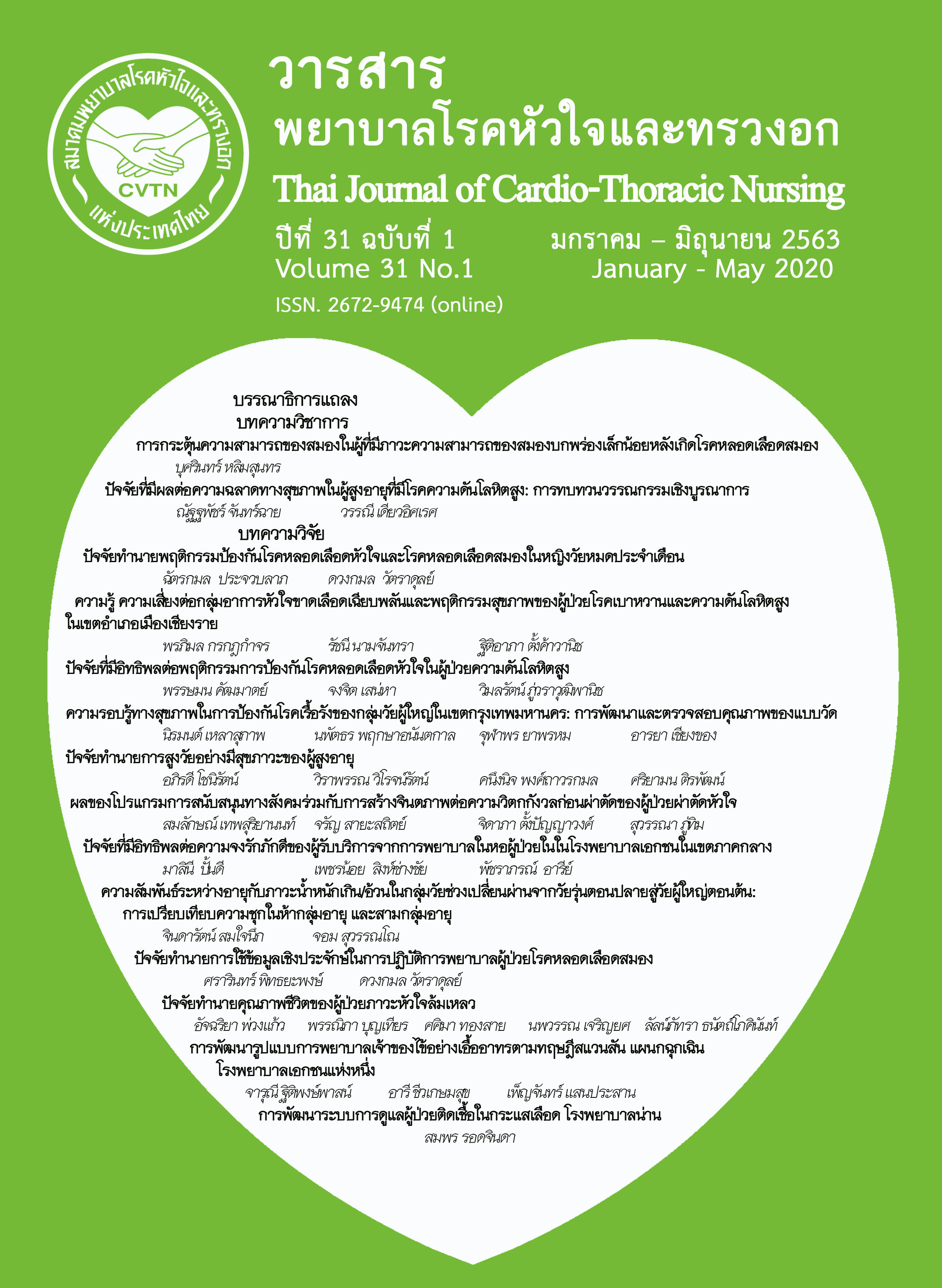Development of a system of care for sepsis patients in Nan hospital
Keywords:
sepsis patients, a system of care, outcomes of careAbstract
The purpose of this research and development was to develop a care system for patients with sepsis in Nan hospital. The sample were selected based on a purposive sampling. There were fifty physicians and registered nurses caring for patients with sepsis at Nan hospital and community hospitals in Nan province. Sixty patients diagnosed with sepsis were divided in two groups. Thirty patients were evaluated before developing a care system. Other thirty patients were evaluated after using a care system. The research instruments were: (1) guidelines for caring patients with sepsis, (2) checklist of compliance with the care of patients with sepsis, and (3) medical history record. The research methodology was divided into three phases as: phase 1: analyzing the situation, problems, and factors affecting the care of patients with sepsis; phase 2: developing the care system for patients with sepsis; phase 3: evaluating of the effectiveness of the developed care system for patients with sepsis. The quantitative data were analyzed using descriptive statistic, and Chi-Square. The qualitative data were analyzed by content analysis.
The results indicated that the developed care system for patients with sepsis in Nan hospital consists of 1) the management system, 2) the service system, and 3) the proficiency enhancement system for physicians and registered nurses in Nan hospital and community hospitals. The outcomes of implementing the developed care system for patients with sepsis revealed that the client outcomes were improved in the screening rate in early detection of patients with sepsis. The complication rate of septic shock and the mortality rate of sepsis patients were tending to decrease. The outcomes of service providers were improved because physicians and registered nurses complied with the care standard of patients with sepsis.
Recommendation: A system of care for patients with sepsis in Nan hospital showed effectively implementation. This should be continuously support and expand to use sustainably.
References
2. Dellinger RP, Levy MM, Rhodes A, Annane D, Gerlach H, Opal SM, et al. Surviving sepsis campaign: international guidelines for management of severe sepsis and septic shock: 2012. Crit Care Med. 2013;41(2):580-637.
3. Rudd KE, Johnson SC, Agesa KM, Shackelford KA, Tsoi D, Kievlan DR, et al. Global, regional, and national sepsis incidence and mortality, 1990-2017: analysis for the Global Burden of Disease Study. The Lancet. 2020;395(10219) :200-11.
4. Ministry of Public Health. The report of Mortality rate in patients with sepsis. Nonthaburi: Ministry of Public Health (MoPH); 2018. (in Thai).
5. Nan Hospital. Medical record and statistics of Nan Hospital 2018. Nan: Nan Hospital; 2018. (in Thai).
6. Treebupachatsakul P, Kamsawang N, Tuandeang P. Clinical outcome after application of CPG for sepsis. Buddhachinaraj Medical Journal. 2009;24 (1):33-45. (in Thai).
7. Mahantassanapong C. Outcome of the Surin sepsis treatment protocol in sepsis management. Srinagarind Medical Journal. 2012;27(4):332-39. (in Thai).
8. Punvittayakool J, Maneeprai J. The development of care model for sepsis. Journal of Nursing Division. 2018;45(1):86-104. (in Thai).
9. Onswadipong P, Sungkard K, Kusuma Na Ayuthya, Rongrungruan Y. The effect of early goal-directed nursing intervention on severity of organ failure in patients with sepsis syndrome. Journal of Nursing Science. 2010;29(2):102–10. (in Thai).
10. Jirakangwan M. Development of nursing model for severe sepsis in Sisaket Hospital Journal of Nursing Divition. 2015;42(3):9-32. (in Thai).
11. Deming WE. Out of the crisis. Massachusetts: Center for Advanced Engineering Study, Massachusetts Institute of Technology, Cambridge; 1982.
12. Pipatvet K. Predisposing factors of mortality in septic patients in Uttaradit Hospital. Thai journal of tuberculosis chest diseases and critical care. 2008;29(1):135-44. (in Thai).
13. Suranatchayanan P, Kenthongdee W, Kamonrat S. Nursing care system development for sepsis patients at Loei Hospital. Journal of Nursing and Health Care 2018;36(1):207-15. (in Thai).
14. Chairatana P. Journal of Nursing and Health Care. 2017;35(3):224-31. (in Thai).
15. Kutragoo R, Chantara P, Yimyam P, Khumpakum S, Namjuntra R. The development of a clinical supervision model for severe sepsis patients.Thai Journal of Cardio-Thoracic Nursing. 2019;30 (2); 193-209. (in Thai).
16. Regional Heath 1. Ministry of Public Health. Thailand. Sepsis data collection form and referral for sepsis patients. Retrieved May 19, 2020 from: https://www.sepnet1.com/login.php.
17. Lisa M. Adam L.Jonas T. Bertil C. John H. Boyd. Parham S. Per Å. Fredrik K. NEWS2 is Superior to qSOFA in Detecting Sepsis with Organ Dysfunction in the Emergency Department. J. Clin. Med. 2019; 8 (8), 1128.
18. Champunot R, Tansuphaswasdikul S, Kamsawang N, Tuandoung P, Thimsri D. Application of Search Out Severity (SOS) Score for Identification of Deteriorating Patients in General Wards. Buddhachinaraj Medical Journal, 2016; 33(3). 313-325. (in Thai).
19. Khwannimit B, Bhuraanontachai R, Vattanavanit V. Comparison of the accuracy of three early warning scores with SOFA score for predicting mortality in adult sepsis and septic shock patients admitted to intensive care unit. Heart Lung. 2019; 4(83), 240-244.
20. Kowtragool N. Effects of Using a Case Management System to improve the quality of care for the Sepsis Patients in Sakaeo Crown Prince Hospital. Thai Journal of Cardio-Thoracic Nursing. 2014;25 (2); 120-134. (in Thai).
21. Potisita C. Science and art of quality research (5th edition). Bangkok: Amarin Printing and Publishing Public Company Limited; 2554. (in Thai).
22. The Thai Society of Critical Care Medicine. Clinical practice guidelines for severe sepsis and septic shock (draft) 2558. Retrieved January 19, 2020 Searched from http://www.sepsiseasy. com/.
23. Noparith P. A Development of Nursing Care Model for Sepsis patients in Mukdahan Hospital. Journal of Nursing and Health Care.2019; 31(1); 221-230. (in Thai).
Downloads
Published
How to Cite
Issue
Section
License
บทความนี้ยังไม่เคยตีพิมพ์หรืออยู่ในระหว่างส่งไปตีพิมพ์ในวารสารอื่น ๆ มาก่อน และกองบรรณาธิการขอสงวนสิทธิ์ในการตรวจทาน และแก้ไขต้นฉบับตามเกณฑ์ของวารสาร ในกรณีที่เรื่องของท่านได้ได้รับการตีพิมพ์ในวารสารฉบับนี้ถือว่าเป็น ลิขสิทธิ์ของวารสารพยาบาลโรคหัวใจและทรวงอก






